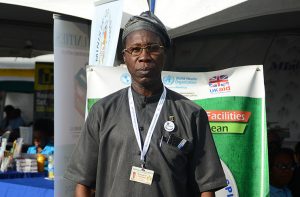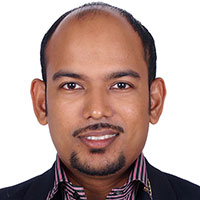– experts urge collective effort to tackle suicide
THE first seven months of this year has seen the occurrence of some 68 deaths by suicide and the Ministry of Public Health statistics suggests that the prevalence of mental health problems among adults and adolescents is about the same, at 15 per cent.
The ministry has recorded a total 184 deaths by suicide in 2017 and 141 in 2018, according to Mental Health Director, Dr. Util Richmond-Thomas.
Dr Richmond-Thomas is an advocate for social worker at every primary healthcare facility to help persons in crisis situations.

“I would like to also advocate for at least two psychologists for every hospital,” she told the Guyana Chronicle and noted that the religious community also play an important role in suicide prevention. Usually, at the first sign of adversity, persons often seek the help of religious leaders before considering the healthcare system.
In 2017, she said the Pan American Health Organisation in collaboration with the Ministry of Public Health and Loma Linda Universiity California, trained religious leaders from the Seventh-Day Adventist Church in problem management.
“This is a proven psychological tool to help persons in distress. We would like to extend this training to other denominations so that we can list the religious leaders as our resource persons,” she said.
The director also welcomed support from the non-governmental organisations and the private sector.
“They have kept knocking at the door and voicing their need to be part of the solution in healthcare. Their contributions have been valuable in helping to carry the load of the ministries and bridging the gap between the communities and the government,” she said.
The mental health director explained that while there have been 68 deaths by suicide in the first seven months of the year, data from far-flung regions take months to get to be officially recorded in Georgetown. For the corresponding period, there were 91 deaths in 2018 and 114 in 2017.
TRAINING
In July of 2019, she said the Mental Health Unit began training teachers to recognise the early signs of mental health issues in children and adolescents and to collaborate with the Public Health Ministry to do early referrals and to support those affected.
“Through this alliance, we hope to decrease the numbers of mental health issues seen in the child and adolescent population,” she said, emphasising that mental health and suicide prevention is everyone’s business and all must play their part.
Often family and friends are the ones who first recognise the warning signs of suicide, and Dr. Richmond-Thomas said they have important roles to play in seeing their loved ones get help and support for recovery.

This is very important, notably in the case of Kavita Persaud. Persaud suffers from traumatic events which resulted in her ex-husband killing himself and almost destroying her with their three-year-old daughter on September 10, 2019.
She recalled it was one of the worst experiences in her life.
Coincidentally, World Suicide Prevention Day was also observed on September, 10, 2019 under the theme “Working Together To Prevent Suicide”.
The 35-year-old mother related to this publication that her ex-husband locked them inside their Martyr’s Ville, Mon Repos, East Coast Demerara house and choked and forced her and their daughter to drink a substance.
Kavita’s ex-husband, 57-year-old Balkaran Persaud, who was a taxi driver, subsequently died as a result of suicide.
On the morning of the incident, Balkaran sent a taxi to pick up Kavita to drop her by his house under the pretext that she had to prepare their three-year-old daughter for school.
But when Kavita got there, the man locked them inside and threatened to kill them and take his life.
“When I go now he pay the taxi and I go in the yard and I ain’t know he padlock the gate; the back door lock and he lock the front door and he shove me down and say, ‘this is the end of me, you and this child, you not gonna be here to punish and look she and I not gonna deh to punish’,” Kavita reflected.
She said the man choked her several times during which she lost consciousness. When she started to spit blood, she begged him to take her to the hospital but he refused.
It was when the little girl asked for something to drink that Kavita used the opportunity steal a call from Balkaran’s cellphone to a neighbour and alert them about what was happening.
“By the time them come over now, he grab me and choke me and then he start to push the thing in meh mouth and I say, this is poison, lose me! And then I bite he finger, when I bite he finger now he grab meh baby and me see he hand deh in she mouth and I grab she and put she down to get the front door open,” the traumatised woman recalled.
Kavita said she fought Balkaran to get the door open for the neighbours to help her. Kavita had ended the relationship with Balkaran after eight years of marriage because he was reportedly abusive.
“After he does curse me every day, I decide to move with meh one daughter and leave the little one with him and go and rent a place and live,” Kavita said.
Kavita had left the three-year-old girl with her father but would go to the man’s house every day to get her dressed for school.
Balkaran had two children from a previous relationship while Kavita also has two others from another relationship.
COLLECTIVE EFFORT
According to Dr. Richmond-Thomas, relatives, friends, colleagues and the public in general have a responsibility to keep themselves informed about the many mental health issues, what they can do to prevent them, and how they can support those afflicted.
“They also need to keep the conversation going to bring mental illness out of the shadows of stigma and discrimination to take its rightful place as just another illness, just like diabetes, just like hypertension,” the mental health director noted.
Adding that the Mental Health Unit has enjoyed the support of many from the time of its formation in May of 2016, Dr. Richmond-Thomas said suicide prevention cuts across all sectors, underscoring the work done in Baramita, Region One in providing alternatives to alcohol use, especially in the area of sport.
She noted in that the use of alcohol has caused some deaths by suicide while persons were under the influence.
The director explained that minimising access to means of suicide is a very important intervention for suicide prevention.
She explained that adversities in life are face by all, but the majority of persons have coping mechanisms which give resilience. However, adversities, over a prolonged period of time, from which there is no perceived escape, cause biochemical changes in the body which precipitates various mental illnesses, especially depression and in the worst cases, self-harm/suicide.
“Our social workers use their skill and knowledge to help their vulnerable clients address, manage and resolve serious social problems. These include drug dependency, physical and emotional abuse, poverty, social support issues, housing, unemployment and discrimination, to name a few. These are stressors which can push one into mental illness. Psychologists, through their various techniques help to bring about the mental and behavioral changes needed to ensure that persons can enjoy a sense of well-being with oneself, can cope with the normal stresses of life, be productive and fruitful and contribute to society,” the mental health director shared.
Psychologist and University of Guyana (UG) lecturer, Wil Campbell, said suicide and suicidality, like most psychosocial issues, is extremely complex.
“Most normal persons at some point or the other have, at least casually, thought of death as an escape from some undesirable circumstance (I’d rather die than have to deal with this or that!),” Campbell said.
But only a fraction of persons actually give this particular option serious thought, the psychologist said, noting that many studies conducted among survivors of suicide attempts show that most suicidal persons did not want to die.
“They just felt it was their best (or only) option at the time,” the psychologist said.
He added, “there is a wide array of factors that could lead a person to this point. They include impaired mental functioning due to drug (alcohol, prescription or illegal) use or mental illness; poor emotion management and impulse control skills, poor problem-solving skills, extreme stress or emotional trauma, a desire to exact revenge on someone, intense feeling of shame, embarrassment or hopelessness, or untreated behavioural or mood disorders such as conduct disorders, anxiety and depression.”
The UG lecturer explained that the most effective intervention for a suicidal person depends on the root cause of the suicidality. For some, medication or talk therapy administered by a trainer professional is most effective.
SUPPORT
For most persons, even those who require professional help, he said a good, responsive and supportive support circle is extremely helpful.
“A burden that many depressed or suicidal people carry, is the feeling like they are a burden to their family and friends. Constant reassurance and demonstrations to the contrary gives them the assurance that someone cares enough to listen. For many, that simple assurance could be the difference between life and death,” he said.
According to the National Suicide Prevention Plan 2015-2020, published in December 2014, Guyana ranked at the top worldwide with an estimated suicide rate of 44.2 per 100,000 population.
The plan indicated that suicide was the leading cause of death among persons aged 25 to 44 years. The most affected age group was 20-49 years (50 per cent) but individuals 13-19 years (16.6 per cent) and 50 years (1.6 per cent) were in high proportion.
Local statistics revealed that males died by suicide more frequently, with a proportion of 4:1.
The highest suicide rate, according to the strategy document was in Region Two which was 52 per 100,000 people followed by Region Six with 50 to 100,000, and Region Three 37 per every 100,000.

Fast forward to present. The Ministry of Public Health recorded a total 184 deaths by suicide in 2017 and 141 in 2018. Using the 2012 population census, the crude rate of deaths by suicide is 24.63 per 100,000 population in 2017 and 18.88 per 100,000 in 2018 in a total population of 746,995 persons.
In 2017, the most deaths occurred in the 20-24 year age group followed by the 15-19 year age group followed those with the 40-44-years age group.
However, the highest rate according to specific population occurred in the 60-64-year age group.
Like 2017, in 2018, the most deaths occurred in the 20-24 years age group, followed by 15-19 years age group. However, in 2018, the third highest by numbers was the 35-39 years age group. Yet again, the highest rate according to specific population was the 60-64 year age group.
In 2017, 69 per cent of the deaths were male. In 2018, this figure jumped to 83 per cent.
“We are very active in ensuring that patients who are admitted to the regional hospitals with self-harm see a psychiatrist, followed by a social worker and a psychologist. We keep in contact with those persons until they are no longer suicidal and link them with the relevant services to address their stressors. Survivors of suicides are assessed for ongoing risks and linked with all necessary services which are indicated. These may be include psychiatric consultation, alcohol and substance abuse treatment, counselling or therapy or financial or other assistance from the Ministry of Social Protection, employment linkages among others,” Dr. Richmond-Thomas explained.
More than 300 healthcare workers (including doctors) have been trained to treat the most common mental health disorders, which includes depression and self-harm/suicide.
Dr. Richmond-Thomas also said health education activities at schools, job sites and health centres have been robust in tackling depression, a major risk factor for suicide.
Senior Psychologist at the Mental Health Unit, Balogun Osunbiyi said the unit focuses considerable human and material resources to educate and provide services for persons in the area of mental health, particularly in tackling issues of drug misuse and its negative effects.
Osunbiyi asserted that mental health illnesses are often misconstrued by society’s preconceived notions of it. According to him, a mere five per cent of the patients that he sees are for insanity while others are persons who are just overwhelmed and would need someone to open up to.
The Mental Health Unit also has a programme that deals with self-harm which can be recognised as a major contributing factor for the reduction of Guyana’s suicide rate, which is currently at 24.6 per cent.
The suicide hotline numbers are [592] – 223-0001, 223-0009 and 623-4444. The toll free number [600-4444] and 623-4444 are also active Whatsapp numbers that persons in need of counselling can access.




.jpg)









